英语常见介词用法
- 格式:doc
- 大小:227.50 KB
- 文档页数:2
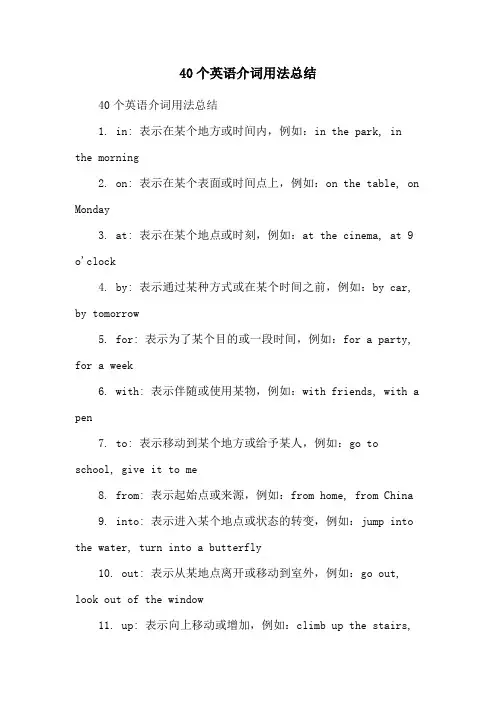
40个英语介词用法总结40个英语介词用法总结1. in: 表示在某个地方或时间内,例如:in the park, in the morning2. on: 表示在某个表面或时间点上,例如:on the table, on Monday3. at: 表示在某个地点或时刻,例如:at the cinema, at 9 o'clock4. by: 表示通过某种方式或在某个时间之前,例如:by car, by tomorrow5. for: 表示为了某个目的或一段时间,例如:for a party, for a week6. with: 表示伴随或使用某物,例如:with friends, with a pen7. to: 表示移动到某个地方或给予某人,例如:go to school, give it to me8. from: 表示起始点或来源,例如:from home, from China9. into: 表示进入某个地点或状态的转变,例如:jump into the water, turn into a butterfly10. out: 表示从某地点离开或移动到室外,例如:go out, look out of the window11. up: 表示向上移动或增加,例如:climb up the stairs,wake up12. down: 表示向下移动或减少,例如:walk down the hill, calm down13. about: 表示关于某事或在某个范围内,例如:talk about the movie, wander about the city14. off: 表示离开或关闭,例如:get off the bus, turnoff the lights15. on: 表示打开或激活,例如:turn on the TV, switch on the computer16. over: 表示越过或在某地上方,例如:jump over the fence, fly over the city17. under: 表示在某物下面或被控制或影响,例如:hide under the bed, live under his rules18. with: 表示具有某种特征或和某人一起做某事,例如:a man with blue eyes, dance with me19. without: 表示没有某物或在缺乏某物的情况下,例如:go without food, live without regret20. by: 表示通过某种方式,例如:learn by doing, go by bus21. through: 表示穿过某物或完成某事,例如:walk through the door, go through the documents22. across: 表示横穿某物或在某个范围内,例如:swimacross the river, all across the world23. between: 表示在两个事物之间或在某个时间段,例如:choose between two options, between 9 and 10 o'clock24. among: 表示在三个或三个以上事物之间或在某群人中,例如:share among friends, discuss among colleagues25. around: 表示在周围或在某个时间点附近,例如:walk around the park, around midnight26. through: 表示通过某事物或在某段时间内,例如:read through the book, work through the night27. against: 表示反对或靠在某物上,例如:fight against injustice, lean against the wall28. for: 表示代表或支持某人或某事,例如:vote for a candidate, fight for freedom29. towards: 表示朝向某个方向或对某人有好感,例如:walk towards the beach, feel towards someone30. within: 表示在某个时间或范围内,例如:arrive within an hour, within the city limits31. beyond: 表示超出某个界限或超过某个程度,例如:beyond expectations, beyond the horizon32. along: 表示沿着某个路线或伴随某人一起,例如:walk along the street, sing along with the song33. above: 表示在某物之上或高于某个程度,例如:flyabove the clouds, above average34. below: 表示在某物之下或低于某个程度,例如:swim below the surface, below freezing35. beside: 表示在某物旁边或和某人一起,例如:sit beside me, beside the lake36. near: 表示在某物附近或接近某个时间,例如:live near the beach, near the end37. past: 表示经过某个地点或在某个时间之后,例如:walk past the store, past midnight38. around: 表示在周围或大约某个数量,例如:look around the room, around 20 people39. after: 表示在某个时间之后或追求某人或某事,例如:after dinner, run after the dog40. before: 表示在某个时间之前或在某个事件之前,例如:before sunrise, before the meeting这些介词是英语中常用的一些基本介词,它们在表达地点、时间、方式等方面起到了重要的作用。
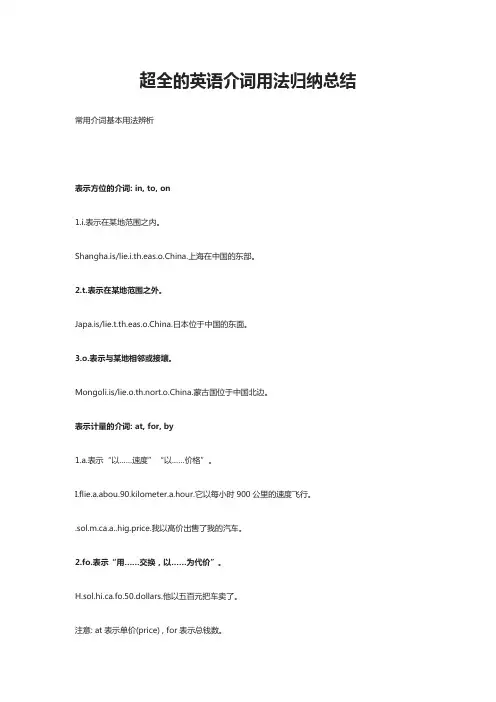
超全的英语介词用法归纳总结常用介词基本用法辨析表示方位的介词: in, to, on1.i.表示在某地范围之内。
Shangha.is/lie.i.th.eas.o.China.上海在中国的东部。
2.t.表示在某地范围之外。
Japa.is/lie.t.th.eas.o.China.日本位于中国的东面。
3.o.表示与某地相邻或接壤。
Mongoli.is/lie.o.th.nort.o.China.蒙古国位于中国北边。
表示计量的介词: at, for, by1.a.表示“以……速度”“以……价格”。
I.flie.a.abou.90.kilometer.a.hour.它以每小时900公里的速度飞行。
.sol.m.ca.a..hig.price.我以高价出售了我的汽车。
2.fo.表示“用……交换,以……为代价”。
H.sol.hi.ca.fo.50.dollars.他以五百元把车卖了。
注意: at表示单价(price) , for表示总钱数。
3.b.表示“以……计”, 后跟度量单位。
The.pai.hi.b.th.month.他们按月给他计酬。
Her.egg.ar.sol.b.weight.在这里鸡蛋是按重量卖的。
表示材料的介词: of, from, in1.o.成品仍可看出原料。
Thi.bo.i.mad.o.paper.这个盒子是纸做的。
2.fro.成品已看不出原料。
Win.i.mad.fro.grapes.葡萄酒是葡萄酿成的。
3.i.表示用某种材料或语言。
Pleas.fil.i.th.for.i.penci.first.请先用铅笔填写这个表格。
The.tal.i.English.他们用英语交谈。
表示工具或手段的介词: by, with, on1.b.用某种方式, 多用于交通。
.wen.ther.b.bus.我坐公共汽车去那儿。
2.with表示“用某种工具”。
H.brok.th.windo.wit..stone.他用石头把玻璃砸坏了。
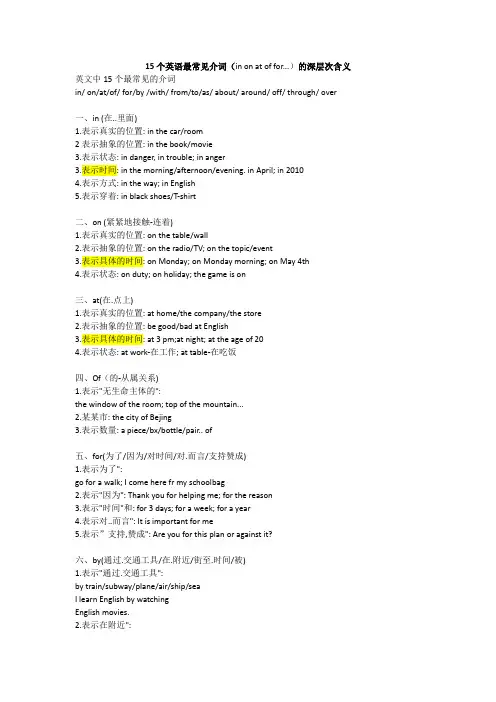
15个英语最常见介词(in on at of for...)的深层次含义英文中15个最常见的介词in/ on/at/of/ for/by /with/ from/to/as/ about/ around/ off/ through/ over一、in (在..里面)1.表示真实的位置: in the car/room2表示抽象的位置: in the book/movie3.表示状态: in danger, in trouble; in anger3.表示时间: in the morning/afternoon/evening. in April; in 20104.表示方式: in the way; in English5.表示穿着: in black shoes/T-shirt二、on (紧紧地接触-连着)1.表示真实的位置: on the table/wall2.表示抽象的位置: on the radio/TV; on the topic/event3.表示具体的时间: on Monday; on Monday morning; on May 4th4.表示状态: on duty; on holiday; the game is on三、at(在.点上)1.表示真实的位置: at home/the company/the store2.表示抽象的位置: be good/bad at English3.表示具体的时间: at 3 pm;at night; at the age of 204.表示状态: at work-在工作; at table-在吃饭四、Of(的-从属关系)1.表示"无生命主体的":the window of the room; top of the mountain...2.某某市: the city of Bejing3.表示数量: a piece/bx/bottle/pair.. of五、for(为了/因为/对时间/对.而言/支持赞成)1.表示为了":go for a walk; I come here fr my schoolbag2.表示"因为": Thank you for helping me; for the reason3.表示"时间"和: for 3 days; for a week; for a year4.表示对..而言": It is important for me5.表示”支持,赞成": Are you for this plan or against it?六、by(通过.交通工具/在.附近/街至.时间/被)1.表示"通过.交通工具":by train/subway/plane/air/ship/seaI learn English by watchingEnglish movies.2.表示在附近":a table by the window; the house is by the lake3.表示"截至到..时间":by the end of next week; by 20194.表示"被(被动语态)":English is spoken by people all over the world.七、with (伴随)1.表示"和.起":go with:play with;make friends with;cooperate with2.表示"携有,带有":a county with a long history; a house with a big garden3.表示..工具:cut the apple with the knife4.表示"伴随":with the development of the society;with the help of my teacher;I don't have any cash with me.八、from (远离)1.表示"来自":I am/come from China;a gift from my best friend;a man from America2.由"远离"来记短语:stop/prevent/keep sb from doing sth阻止某人做某事be away from...远离...be different from与.不同be absent from缺席....how far is it from here?它离这远The paper is made from wood.这纸是由木头制成的3.表示..到": from...to...由"指向"来理解下列用法:The road leads to Paris.这条路通往巴黎Smoking is harmful to your health.吸烟有害健康the answer to the question.这个问题的答案九、to (指向..)contribute to对..做贡献on one's way to... 在某人去某地的路上belong to属于..be used to doing sth习惯于做某事lead to...导致十、as作为He works as a tour guide.他作为导游工作。
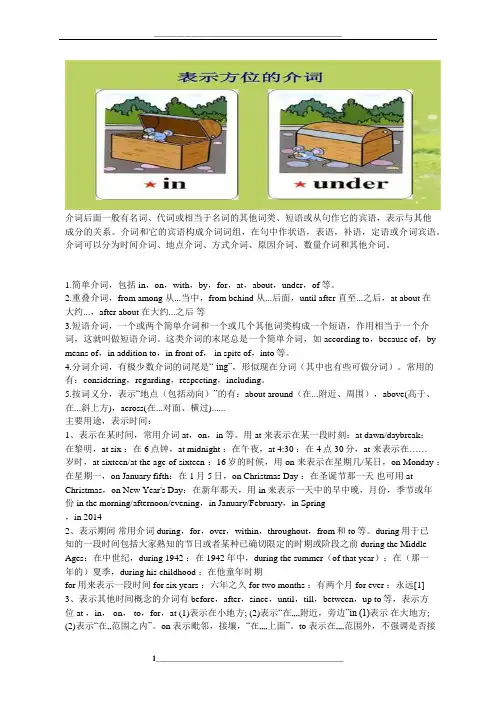
介词后面一般有名词、代词或相当于名词的其他词类、短语或从句作它的宾语,表示与其他成分的关系。
介词和它的宾语构成介词词组,在句中作状语,表语,补语,定语或介词宾语。
介词可以分为时间介词、地点介词、方式介词、原因介词、数量介词和其他介词。
1.简单介词,包括in,on,with,by,for,at,about,under,of等。
2.重叠介词,from among 从...当中,from behind 从...后面,until after 直至...之后,at about 在大约...,after about 在大约...之后等3.短语介词,一个或两个简单介词和一个或几个其他词类构成一个短语,作用相当于一个介词,这就叫做短语介词。
这类介词的末尾总是一个简单介词,如 according to,because of,by means of,in addition to,in front of, in spite of,into等。
4.分词介词,有极少数介词的词尾是“-ing”,形似现在分词(其中也有些可做分词)。
常用的有:considering,regarding,respecting,including。
5.按词义分,表示“地点(包括动向)”的有:about around(在...附近、周围),above(高于、在...斜上方),across(在...对面、横过)......主要用途,表示时间:1、表示在某时间,常用介词at,on,in等。
用 at 来表示在某一段时刻:at dawn/daybreak:在黎明,at six :在6点钟,at midnight :在午夜,at 4:30 :在4点30分,at 来表示在……岁时,at sixteen/at the age of sixteen :16岁的时候,用 on 来表示在星期几/某日,on Monday :在星期一,on January fifth:在1月5日,on Christmas Day :在圣诞节那一天也可用at Christmas,on New Year's Day:在新年那天,用in来表示一天中的早中晚,月份,季节或年份in the morning/afternoon/evening,in January/February,in Spring,in 20142、表示期间常用介词during,for,over,within,throughout,from和to等。
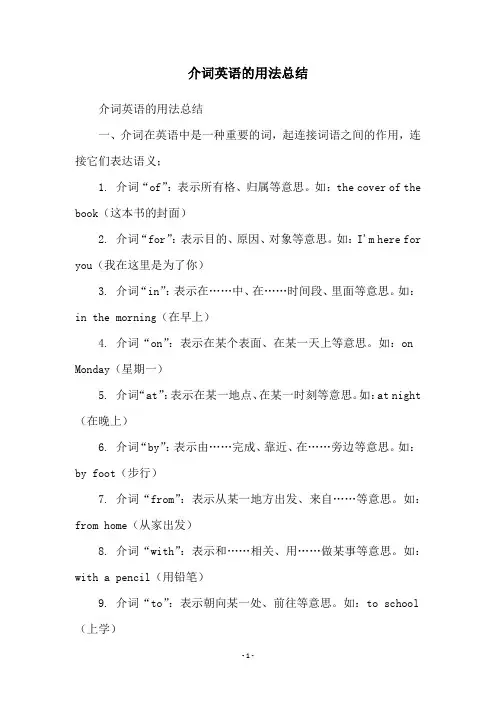
介词英语的用法总结介词英语的用法总结一、介词在英语中是一种重要的词,起连接词语之间的作用,连接它们表达语义;1. 介词“of”:表示所有格、归属等意思。
如:the cover of the book(这本书的封面)2. 介词“for”:表示目的、原因、对象等意思。
如:I'm here for you(我在这里是为了你)3. 介词“in”:表示在……中、在……时间段、里面等意思。
如:in the morning(在早上)4. 介词“on”:表示在某个表面、在某一天上等意思。
如:on Monday(星期一)5. 介词“at”:表示在某一地点、在某一时刻等意思。
如:at night (在晚上)6. 介词“by”:表示由……完成、靠近、在……旁边等意思。
如:by foot(步行)7. 介词“from”:表示从某一地方出发、来自……等意思。
如:from home(从家出发)8. 介词“with”:表示和……相关、用……做某事等意思。
如:with a pencil(用铅笔)9. 介词“to”:表示朝向某一处、前往等意思。
如:to school (上学)10.介词“for”:表示为了……、把……作为等意思。
如:for fun (为了好玩)11.介词“as”:表示作为、当……时等意思。
如:as a teacher (作为一个老师)12.介词“over”:表示在……上、穿过等意思。
如:over the bridge (过桥)13.介词“since”:表示从……起、既然等意思。
如:since then (从那时起)14.介词“into”:表示到……里面、转向等意思。
如:into the room(进房间)二、最后,需要强调的是,介词的使用要灵活搭配,以正确表达出英语句子的意思,以便达到更好的英语表达效果。
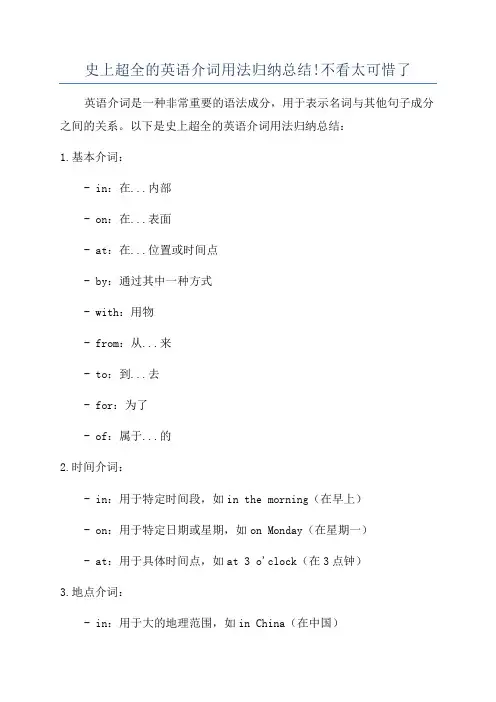
史上超全的英语介词用法归纳总结!不看太可惜了英语介词是一种非常重要的语法成分,用于表示名词与其他句子成分之间的关系。
以下是史上超全的英语介词用法归纳总结:1.基本介词:- in:在...内部- on:在...表面- at:在...位置或时间点- by:通过其中一种方式- with:用物- from:从...来- to:到...去- for:为了- of:属于...的2.时间介词:- in:用于特定时间段,如in the morning(在早上)- on:用于特定日期或星期,如on Monday(在星期一)- at:用于具体时间点,如at 3 o'clock(在3点钟)3.地点介词:- in:用于大的地理范围,如in China(在中国)- on:用于较小的地理范围或表面,如on the street(在街上)- at:用于具体地点,如at the supermarket(在超市)4.方向介词:- to:表示到达一些地方,如go to school(去学校)- into:表示进入一些地方,如go into the house(进入房子)- out of:表示离开一些地方,如get out of the car(离开车)5.原因介词:- because of:由于,如He is late because of the traffic(他因为交通堵塞而迟到)- due to:由于,如The flight was canceled due to bad weather(因为恶劣天气,航班被取消)6.动词短语介词:- look after:照顾,如She looks after her younger brother (她照顾她的弟弟)- take care of:照顾,如He takes care of his plants(他照顾他的植物)7.形容词短语介词:- interested in:对...感兴趣,如She is interested in music (她对音乐感兴趣)- good at:擅长...,如He is good at playing basketball(他擅长打篮球)8.其他常见介词用法:- with regard to:关于,如With regard to the matter, I have something to say(关于这件事,我有些话要说)- instead of:代替,如I will go instead of him(我将代替他去)- according to:根据,如According to the weather forecast, it will rain tomorrow(根据天气预报,明天会下雨)以上是一些常见的英语介词用法总结,希望能帮到你!。
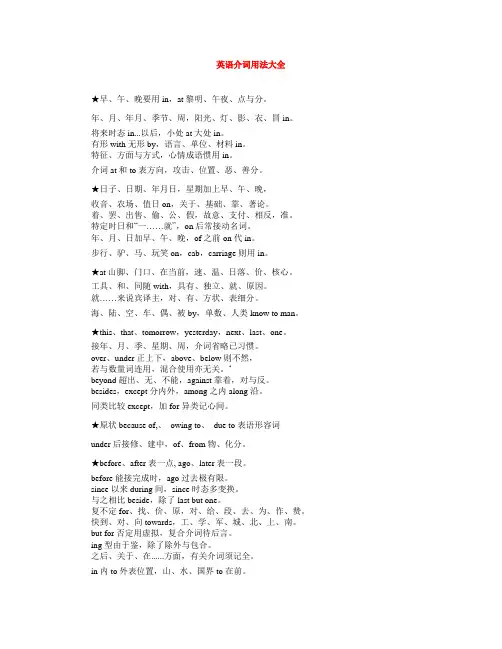
英语介词用法大全★早、午、晚要用in,at黎明、午夜、点与分。
年、月、年月、季节、周,阳光、灯、影、衣、冒in。
将来时态in...以后,小处at大处in。
有形with无形by,语言、单位、材料in。
特征、方面与方式,心情成语惯用in。
介词at和to表方向,攻击、位置、恶、善分。
★日子、日期、年月日,星期加上早、午、晚,收音、农场、值日on,关于、基础、靠、著论。
着、罢、出售、偷、公、假,故意、支付、相反,准。
特定时日和“一……就”,on后常接动名词。
年、月、日加早、午、晚,of之前on代in。
步行、驴、马、玩笑on,cab,carriage则用in。
★at山脚、门口、在当前,速、温、日落、价、核心。
工具、和、同随with,具有、独立、就、原因。
就……来说宾译主,对、有、方状、表细分。
海、陆、空、车、偶、被by,单数、人类know to man。
★this、that、tomorrow,yesterday,next、last、one。
接年、月、季、星期、周,介词省略已习惯。
over、under正上下,above、below则不然,若与数量词连用,混合使用亦无关。
…beyond超出、无、不能,against靠着,对与反。
besides,except分内外,among之内along沿。
同类比较except,加for异类记心间。
★原状because of,、owing to、due to表语形容词under后接修、建中,of、from物、化分。
★before、after表一点, ago、later表一段。
before能接完成时,ago过去极有限。
since以来during间,since时态多变换。
与之相比beside,除了last but one。
复不定for、找、价、原,对、给、段、去、为、作、赞。
快到、对、向towards,工、学、军、城、北、上、南。
but for否定用虚拟,复合介词待后言。
ing型由于鉴,除了除外与包合。
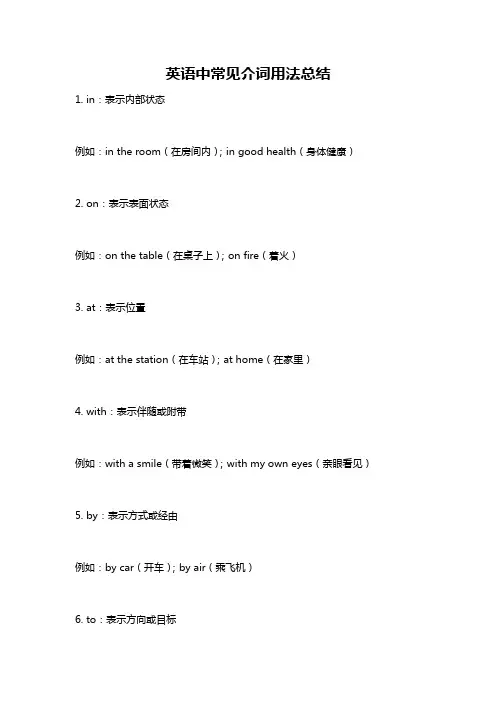
英语中常见介词用法总结
1. in:表示内部状态
例如:in the room(在房间内);in good health(身体健康)2. on:表示表面状态
例如:on the table(在桌子上);on fire(着火)
3. at:表示位置
例如:at the station(在车站);at home(在家里)
4. with:表示伴随或附带
例如:with a smile(带着微笑);with my own eyes(亲眼看见)5. by:表示方式或经由
例如:by car(开车);by air(乘飞机)
6. to:表示方向或目标
例如:to the park(去公园);to the moon(到月球)
7. from:表示出发地或来源
例如:from Beijing(来自北京);from the magazine(从杂志中)
8. for:表示目的或用途
例如:for a birthday party(为了生日派对);for writing(用于写作)
9. of:表示属于或关系
例如:the book of Harry Potter(哈利·波特的书);the sister of Mary(玛丽的姐姐)
10. with:表示具有或伴随
例如:a man with a gun(拿着枪的人);a girl with long hair(长发女孩)。
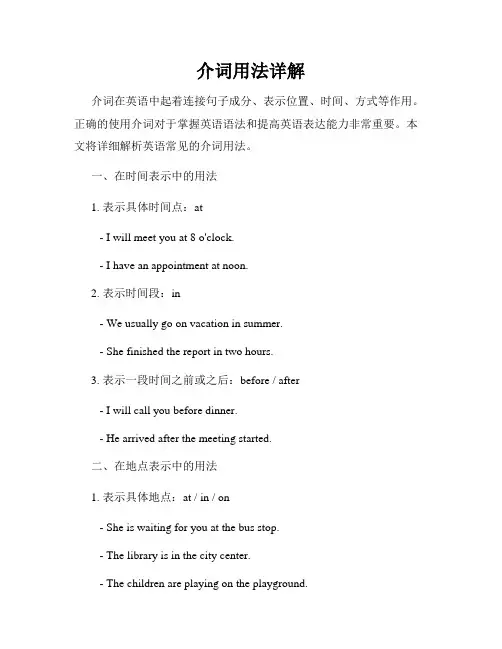
介词用法详解介词在英语中起着连接句子成分、表示位置、时间、方式等作用。
正确的使用介词对于掌握英语语法和提高英语表达能力非常重要。
本文将详细解析英语常见的介词用法。
一、在时间表示中的用法1. 表示具体时间点:at- I will meet you at 8 o'clock.- I have an appointment at noon.2. 表示时间段:in- We usually go on vacation in summer.- She finished the report in two hours.3. 表示一段时间之前或之后:before / after- I will call you before dinner.- He arrived after the meeting started.二、在地点表示中的用法1. 表示具体地点:at / in / on- She is waiting for you at the bus stop.- The library is in the city center.- The children are playing on the playground.2. 表示方向:to / towards- I walked to the park.- They ran towards the exit.三、在方式表示中的用法1. 表示方式和手段:by- We traveled to Beijing by train.- He sent the document by email.2. 表示交通工具:on / by- I go to work on foot.- She goes to school by bus.四、在原因和目的表示中的用法1. 表示原因:because of- The game was canceled because of the bad weather. - He couldn't attend the party because of his illness.2. 表示目的:for- I bought a gift for my friend's birthday.- We studied hard for the upcoming exam.五、在其他表示中的用法1. 表示关系:of- The book on the table is mine.- The color of the car is blue.2. 表示所属关系:of- The top of the mountain was covered in snow.- The tail of the dog was wagging happily.总结:介词在英语中有着不同的用法,包括时间、地点、方式、原因和目的等方面。
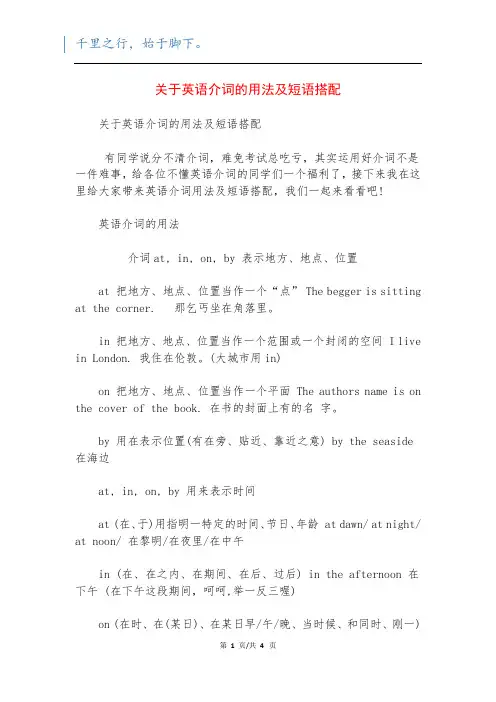
关于英语介词的用法及短语搭配关于英语介词的用法及短语搭配有同学说分不清介词,难免考试总吃亏,其实运用好介词不是一件难事,给各位不懂英语介词的同学们一个福利了,接下来我在这里给大家带来英语介词用法及短语搭配,我们一起来看看吧!英语介词的用法介词at, in, on, by 表示地方、地点、位置at 把地方、地点、位置当作一个“点” The begger is sitting at the corner. 那乞丐坐在角落里。
in 把地方、地点、位置当作一个范围或一个封闭的空间 I live in London. 我住在伦敦。
(大城市用in)on 把地方、地点、位置当作一个平面 The authors name is on the cover of the book. 在书的封面上有的名字。
by 用在表示位置(有在旁、贴近、靠近之意) by the seaside 在海边at, in, on, by 用来表示时间at (在、于)用指明一特定的时间、节日、年龄 at dawn/ at night/ at noon/ 在黎明/在夜里/在中午in (在、在之内、在期间、在后、过后) in the afternoon 在下午 (在下午这段期间,呵呵,举一反三喔)on (在时、在(某日)、在某日早/午/晚、当时候、和同时、刚一)on the first 在一号(指某月一号,如二号要说second等。
其实意思是指某月的第几天)by (的时候、到、等到已经) 用在天、时间 by 2 oclock 到两点钟for, since 用于表示时间用 for 用计量时间(年、月、日、时、分、秒等) He held his breath for five minutes. 他闭息达五分钟。
用 since 表示明确的日期或时间 Hes woked here since 1980. 自从1970年他就在此工作。
表示动作的介词:to ,toward或不用介词用 to 表示向某处移动 They were driving to work together. 他们一同开车去工作。
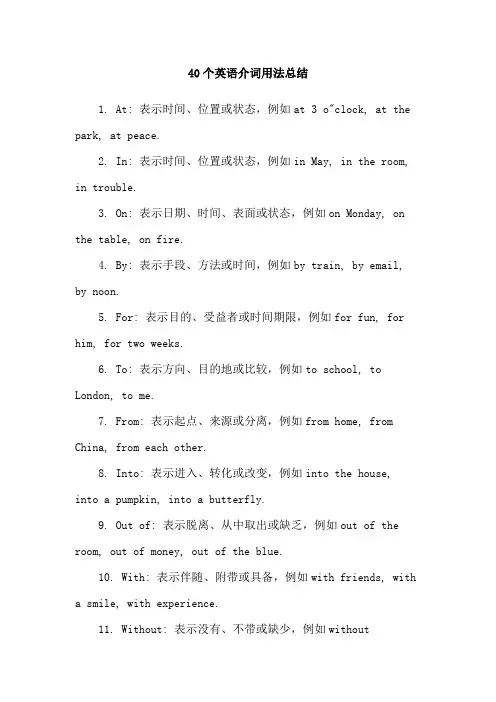
40个英语介词用法总结1. At: 表示时间、位置或状态,例如at 3 o"clock, at the park, at peace.2. In: 表示时间、位置或状态,例如in May, in the room, in trouble.3. On: 表示日期、时间、表面或状态,例如on Monday, on the table, on fire.4. By: 表示手段、方法或时间,例如by train, by email, by noon.5. For: 表示目的、受益者或时间期限,例如for fun, for him, for two weeks.6. To: 表示方向、目的地或比较,例如to school, to London, to me.7. From: 表示起点、来源或分离,例如from home, from China, from each other.8. Into: 表示进入、转化或改变,例如into the house,into a pumpkin, into a butterfly.9. Out of: 表示脱离、从中取出或缺乏,例如out of the room, out of money, out of the blue.10. With: 表示伴随、附带或具备,例如with friends, witha smile, with experience.11. Without: 表示没有、不带或缺少,例如withoutpermission, without shoes, without doubt.12. Over: 表示覆盖、超过或结束,例如over the roof, over the limit, over and done with.13. Under: 表示在下面、被支配或不足,例如under the table, under his control, under budget.14. About: 表示关于、大约或忙于,例如about the movie, about 10 dollars, about to leave.15. Above: 表示在上面、高于或超过,例如above the clouds, above average, above suspicion.16. Below: 表示在下面、低于或不足,例如below the surface, below freezing, below par.17. Across: 表示横穿、相交或涉及,例如across the street, across the board, across his mind.18. Beyond: 表示超出、远离或除了,例如beyond repair, beyond belief, beyond her control.19. Around: 表示周围、附近或环绕,例如around the corner, around the clock, around the world.20. Before: 表示以前、在前面或比较,例如before noon, before the house, before his time.21. Behind: 表示在后面、落后或背后,例如behind the house, behind schedule, behind the scenes.22. Beside: 表示在旁边、与...相比或附加,例如besidethe river, beside myself, beside the point.23. Inside: 表示内部、在里面或被包含,例如inside the box, inside the building, inside information.24. Outside: 表示外部、在外面或超出,例如outside the house, outside the box, outside the norm.25. Through: 表示穿过、经过或完成,例如through the door, through the park, through with it.26. Throughout: 表示遍布、贯穿或在整个期间,例如throughout the city, throughout history, throughout the day.27. Towards: 表示朝向、对于或接近,例如towards the sun, towards him, towards the end.28. Against: 表示反对、抵抗或紧挨着,例如against the law, against the current, against the wall.29. Among: 表示在...之中、相互之间或被分配到,例如among friends, among the stars, among the winners.30. Between: 表示在两者之间、在中间或相互之间,例如between two trees, between classes, between you and me.31. Within: 表示在内部、在范围之内或在规定时间内,例如within the house, within the budget, within a week.32. Without: 表示在外面、没有或不用,例如without the room, without a doubt, without further ado.33. Beneath: 表示在下面、低于或不足,例如beneath the surface, beneath his dignity, beneath contempt.34. Beside: 表示在旁边、与...相比或附加,例如beside the river, beside myself, beside the point.35. Into: 表示进入、转化或改变,例如into the house, into a pumpkin, into a butterfly.36. Upon: 表示在...之上、一旦发生或基于,例如upon the hill, upon arrival, upon further consideration.37. With: 表示伴随、附带或具备,例如with friends, witha smile, with experience.38. Within: 表示在内部、在范围之内或在规定时间内,例如within the house, within the budget, within a week.39. Without: 表示没有、不带或缺少,例如without permission, without shoes, without doubt.40. Beneath: 表示在下面、低于或不足,例如beneath the surface, beneath his dignity, beneath contempt.。
英语中的介词有哪些常见用法?英语中的介词有许多常见的用法和搭配。
以下是一些常见的介词用法:1. 表示位置或方向:-in(在),on(在…上),at(在…处),under(在…下),over(在…上方),above(在…之上),below(在…之下),between(在…之间),among(在…之中),beside(在…旁边),behind(在…后面),in front of(在…前面)等。
2. 表示时间:- at(在…时刻),in(在…期间),on(在…日期),before(在…之前),after(在…之后),during(在…期间),since(自从…以来),for(持续了…)等。
3. 表示原因、目的或理由:- because of(因为),due to(由于),for(为了),to(为了),with(带着),without(没有)等。
4. 表示方式或手段:- by(通过),with(用),through(通过),in(以…方式)等。
5. 表示关系:- of(属于),from(来自),to(给),for(为),about(关于),with(与…有关),among (在…之中),between(在…之间)等。
6. 表示比较或对比:- than(比),as(作为),like(像)等。
7. 表示目标或方向:- to(到),toward(朝向),into(进入),onto(到…上)等。
8. 表示条件:- if(如果),unless(除非),provided(假如),in case(以防)等。
9. 表示顺序:- before(在…之前),after(在…之后),until(直到)等。
10. 表示数量或比例:- of(…的一部分),out of(从…中)等。
以上仅是介词的一些常见用法,实际上介词在不同的句子和语境中还有更多的用法和搭配。
熟练掌握这些常见的介词用法可以帮助我们更准确地表达位置、时间、原因、方式和关系等概念。
常见的英语介词有:in,on,with,by,for,at,about,under,of,to 等。
in作介词时意为“在……内;进……里;在……位置;在……期间;在……以后;穿着(后一般跟颜色);在……状态中;在……方面;包含在……中;从事……;用……语言,以……媒介;以……调;在(活动)过程中;在……岁数;当……时;(引出具某种品质的人的名字);占……;在……之中(用于较大和较小数字之间);以……的数量;带……颜色的;以……方式;具有……特性;按照(表示方式)”。
例句:Have you like images in this?有你们喜欢的偶像在这吗?on作介词时意为“在……之上;向,朝;关于;在……时候;由……支撑;(身上)带着;一……就;吃,喝;接近;根据;挣……钱;以……支付;以……为燃料;在……中;作为……成员;借助(仪器或器械);与……相比;增加;靠……服用药物;(由电台或电视)播放;忙碌于”。
例句:I have to disagree with you on this.在这件事情上我不同意你的看法。
with作介词时意为“和……在一起;具有;用;反对;关于;包括;由于;随着;顺着;受雇于;虽然;支持;穿着;受……影响;表示与某物分离;由……负责”。
例句:I am one with you on this.在这一点上,我和你的意见是一致的。
by作介词时意思是“由,被;通过;相差……;到……之前;在……旁边”。
例句:The telephone is by the window.电话在窗户旁边。
for作介词的时候,它翻译为“(表示对象、用途等)给,对;为了;关于;代表;受雇于;意思是;支持;因为;为得到;换取;就……而言;……后(更好、更快乐等);(表示去向)往;(安排或预定)在……时;对(某人)来说(困难、必需、愉快等);以……为价格;(表示一段时间)计;表示一系列事件之一。
例句:Can you translate this letter for me?你能为我翻译这封信吗?at(表示位置)在;在(某时间或时刻);以,达;向,朝。
英语中的介词该如何使用介词在英语中是非常常见的语法元素,用于表达位置、方向、时间、方式等等。
正确地使用介词可以使句子更加准确和流畅。
本文将介绍英语中介词的用法和一些注意事项。
一、介词的定义和分类介词是一类用于连接名词、代词、动名词、动词不定式等词语的词汇。
它通常位于名词短语或者从句之前,用于表示名词短语或从句与其他部分之间的关系。
介词可以分为以下几类:1. 时间介词:表示时间关系,如in(在……之内)、on(在……之上)、at(在……时刻)等。
2. 地点介词:表示地点关系,如in(在……里面)、on(在……上面)、at(在……旁边)等。
3. 方式介词:表示方式或手段关系,如by(通过)、with(用)等。
4. 原因介词:表示原因关系,如because of(因为)、due to(由于)等。
5. 目的介词:表示目的关系,如for(为了)、to(向着)等。
6. 关系介词:表示两个词之间的关系,如of(……的)、from (从……来)等。
二、介词的使用规则1. 与特定名词搭配:有些介词与特定的名词搭配使用,如depend on(依赖)、belong to(属于)等,这些搭配是固定的,需要记忆。
2. 表示时间:in用于年份、季节等长时间段,如in 2022(在2022年);on用于具体的某一天、日期,如on Monday(在星期一);at 用于具体的时刻,如at 7 o'clock(在7点钟)。
3. 表示地点:in用于较大的地区或地方,如in China(在中国);on用于较小的平面上,如on the table(在桌子上);at用于具体的地址或固定地点,如at the airport(在机场)。
4. 表示方式:with表示伴随或使用的方式,如with a pen(用一支笔);by表示通过的手段或方法,如by bus(乘坐公交车)。
5. 表示原因:because of和due to都表示因为的意思,但due to通常用于正式文体,如due to bad weather(由于天气恶劣)。
英语介词用法大全一、介词preposition缩写prep,又叫前置词,表示其后的名词或代词(或是相当于名词的其他短语或从句)与其他句子成分的关系。
介词是一种虚词,不能单独在句中作成分。
二. 常用介词用法区分:1、in, on, to表示地理位置:in表示在某范围内,on指与什么毗邻,to指在某环境范围之外;2、on, in表示“在…上”时:on只表示在某物的表面上,in表示占去某物一部分;3、through, across都表示“穿过”时:through表示从内部通过,与in有关,across表示在表面上通过,与on有关;4、since, from表示表示时间时:since 指从过去到现在的一段时间,和完成时连用,from指从时间的某一点开始;5、in, on, at表示时间时:at表示片刻的时间,in表示一段的时间,on总是与日子有关;6、in, after表示时间时:in指在一段时间之后,after表示某一具体时间点之后或用在过去时的一段时间中;7、about, on表示“关于”时:about指涉及到,on指专门论述;8、besides与except表示“除了”:besides指“除了…还有再加上”,except指“除了,减去什么”,不放在句首;9、between与among表示“在两者之间”:between表示在两者之间,among用于三者或三者以上的中间;10、in, with表示“用”时:with表示具体的工具,in表示材料,方式,方法,度量,单位,语言,声音;11、in与into表示在里面:in通常表示位置(静态),into表示动向,不表示目的地或位置。
12、as与like:as意为“作为,以…地位或身份”,like为“象…一样”,指情形相似;三、介词用法口诀1、年月周前要用in,遇到几号用on,上午下午又是in.要说某日上下午,on换成in,午夜黄昏用at,黎明用它也不借。
at也在时分前,说“差”要用to,说“过”用part。
英语中所有介词的用法
介词是一种用来连接名词、代词、动词或其他词与其前面的词之间关系的词类。
下面是一些常见的介词及其用法:
1. in(在、在…之内):表示位置,如in the room(在房间里);也表示时间,在未来;也可以用来表示状态,如in trouble(有麻烦)。
2. on(在、在…上):表示接触,如on the table(在桌子上);表示时间,如on Monday(在星期一);也可以表示方式,如on foot(步行)。
3. at(在、在…时):表示位置,如at the park(在公园);
表示时间,如at 6 o'clock(在六点钟)。
4. by(通过、靠近):表示方式,如by taxi(乘坐出租车);也表示靠近,在旁边;还可以表示时间,如by June(到六月
之前)。
5. for(为、给):表示目的或原因,如study for a test(为考
试而学习);也表示时间段,如for two weeks(两周)。
6. with(和、用):表示具有某种特征,如a girl with blue
eyes(有蓝眼睛的女孩);也可以表示通过某种方式、手段,
如write with a pen(用钢笔写)。
7. from(从、来自):表示出处,如from the store(从商店
里);表示起点,如from London(从伦敦)。
8. to(到、向):表示目的地,如go to school(去学校);表示方向,如face to the north(面朝北方)。
这只是一部分介词的使用方法,介词的用法还有很多,需要根据具体语境来理解和运用。
英语中介词的意思及用法英语中介词是冠词、代词、数词、动词等做状语、定语、表语等作用时,连接他们的词语。
在英语中,介词绝大多数都有主语和宾语,表示主语和宾语之间的一种关系。
英语中介词分为常用介词和少用介词。
一、常用介词常用介词有in, on, at, from, to, with, for, of, in front of, behind, under, over, above, below, along, between, among, before, after, through, across, during, beside, by等。
1、inin表示“在...之内”的意思,表示物体的物理位置,或者表示状态,或者表示某一段时间之内。
例如:The book is in the classroom. 书在教室里。
She was in the hospital last week.上星期在医院里。
2、onon表示“在...上面”的意思,一般表示物体的物理位置,或者某处正在进行的活动。
例如:The book is on the table. 书在桌子上。
They are having a meeting on the fourth floor. 他们正在四楼开会。
3、atat表示“在...旁边”的意思,表示物体的物理位置。
例如:The girl is at the window.孩在窗户旁边。
4、fromfrom表示“从...起”的意思,表示某处的起始点。
例如:She comes from China.来自中国。
5、toto表示“至...终点”的意思,表示某处的终点。
例如:He is going to the station. 他正去车站。
6、withwith表示“和...一起”的意思,一般表示一起行动或一起出现的情况,也可以表示和某人有某种特定的关系。
例如:The children are playing with their teacher.子们和老师一起玩。
英语常见介词用法1.让我来帮你完成工作吧。
Incorrect: Let me help you to do your work. Correct: Let me help you with your work.
2.我建议你去休个长假。
Incorrect: I recommend you to take a long vacation. Correct: I recommend that you take a long vacation.
3.过来。
Incorrect: Come to here.
Correct: Come here.
4.太阳从东方升起。
Incorrect: The sun rises from the East.
Correct: The sun rises in the East.
5.小偷是从窗户爬进来的。
Incorrect: The thief got in from the window. Correct: The thief got in through the window.
6.让我们从第10页开始。
Incorrect: Let's begin from page 10.
Correct: Let's begin at(on) page 10.
7. 我耐心有限。
Incorrect: There is a limit in my patience. Correct: There is a limit to my patience.
8. 请在白线内等待。
Incorrect: Please wait inside the white line. Correct: Please wait behind the white line.
9.你家房子买了火险吗?
Incorrect: Is your house insured for fire? Correct: Is your house insured against fire?
10. 我没地方住。
Incorrect: I have no house to live. Correct: I have no house to live in.。